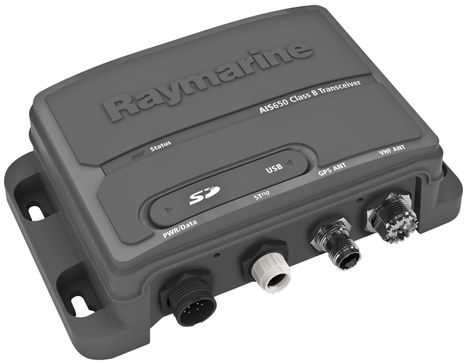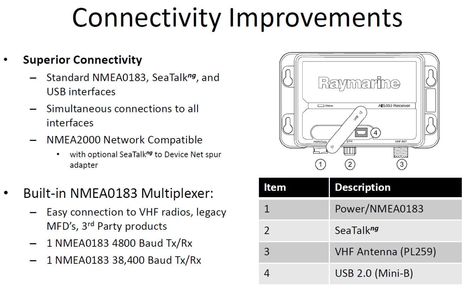Raymarine AIS650 & AIS350: smaller, better, and somewhat familiar

Yesterday Raymarine issued a press release announcing replacements for its existing AIS receiver and Class B transponder, which I'll link to when possible. But, in fact, some online dealers are already offering the AIS650 Class B transponder, as well as the AIS350 receiver, and they also bear a family resemblance to the new generation SRT OEM gear discussed in June, which is not a bad thing (and no big surprise given that SRT announced a strategic agreement with one of "the world's top three marine electronics companies" last February). Let's see if we can figure out what's new and different...
Well, both these AIS devices certainly are compact and connected. Both offer simultaneous NMEA0183, SeaTalkNG/NMEA2000, and USB interfaces, so I don't think that there is an AIS plotting display alive that can't easily receive their data output. I also like how Raymarine explicitly states that its proprietary SeaTalkNG port is compatible with N2K by simply using an optional DeviceNet cable adapter (the male version, Raymarine part # A06046). And I'm fairly confident that they will interoperate fine with other manufacturer's N2K AIS displays as the early problems in that area happened because NMEA was slow to complete the AIS PGN (message) set, but that time is past. (Hopefully Raymarine will get these devices certified, but as I've been saying certification doesn't absolutely guarantee data compatibility, unfortunately.)
I like AIS over NMEA 2000 (or SeaTalkNG or SimNet) because it thus gets to all displays without having to pass through one in particular to get onto a network and also because it usually means that a Class B transponder can easily get Heading information, which will keep your target looking right even when you're stopped. But I gather that the AIS650 does not broadcast its RAIM-verified GPS data onto N2K -- I don't think the other N2K transponders from Garmin, Navico, etc. do either -- which I don't understand. It makes sense to omit or limit GPS over NMEA 0183 because of bandwidth limitations but why not go full bore, primary-nav-capable on N2K?
At any rate, it's nice that the new AIS650 has both hardware and software switches for Silent Mode (receive only), though I suspect the latter will only work with Ray MFDs. And I also like the new transponder's SD card for software updates, MMSI programming, and voyage data recording, though it was disappointing to hear that the latter only covers the last 30 minutes of a voyage. {Correction: The design was changed so that it records right up to limit of the card and then let's you know it's full. Nice!} I was also hoping for lower prices than the AIS350's MSRP of $649 {Changed to $549} and the AIS650's of $999, but they are lower than the previous models and of course subject to discounting. And the competition may get intense when the very similar, if somewhat mysterious, Em-Trak B100 Class B hits the streets.
Incidentally, the Raymarine press release states that the AIS650 has not yet received FCC approval, and therefore is not yet for sale in the U.S., but I heard yesterday that the FCC just granted that approval.


 Share
Share
I, too, like (the concept of) AIS over NMEA2000. However, for those of us who rely on PC-hosted navigation software (rather than proprietary MFDs) the current ability to get AIS targets onto the PC using N2K PGNs is limited.
Maretron recently advised me that "...We currently do not have plans to update the AIS pgn’s into the USB100...." and recommended the Actisense gateway. The Actisense NGT-1 does support "beta" version firmware that converts AIS PGN, but has received little feedback from the user community to date.
Rose Point also offers a gateway (which I understand is based on the Actisense product) but their website is silent about AIS or any other other PGN translations. In fact, Rose Point advertises as a "feature" of their product that it functions "...without the need for firmware upgrades to support new types of devices...." I gotta wonder how that works to future-proof this product.
It seems that most, if not all, PC-hosted navigation software continues to rely on NMEA0183 sentences for nav data. As a result, a translating gateway is a necessity. Am I missing something?